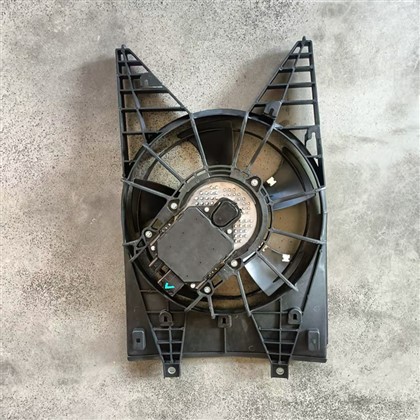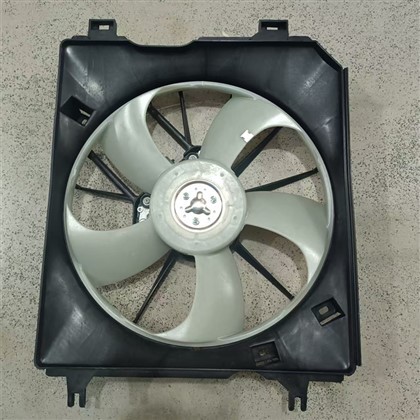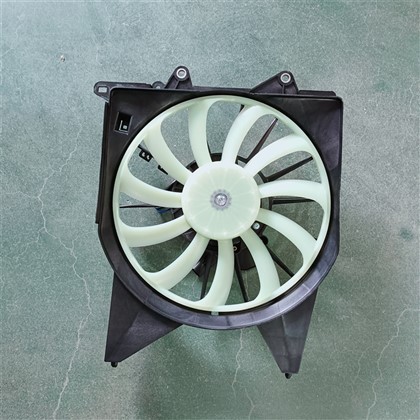What is Fan Assembly?
A fan assembly moves hot air away from a high-temperature region to protect components that could be damaged by high heat. Air is pulled towards the center of the fan assembly, and then exhausted across the entire surface area. Inside of a computer case, a processor or graphics card can produce significant heat. Along with heat sinks, the fan assembly dissipates this heat and maintains safe operating temperatures.
Advantages of Fan Assembly
Free choice of spare parts and customized fans
Assembling the fan means installing the various parts together step by step to finally form a complete fan. Different from existing brand fans, you can freely choose various spare parts when assembling the fan.
Improve service life
Assembling the fan can not only meet your own personalized needs, but also extend the service life of the fan. Because the selected parts are of high quality and can be properly maintained and updated, the assembled fans are often more durable than branded fans on the market.
Enjoy diy fun
There is a certain amount of diy fun in the process of assembling the fan. The process requires patience, care, and a certain amount of skill, but it's not complicated. Not only can it help you practice your skills, but it can also give you a sense of pride and accomplishment.
-
Honda City1.5 And Fit09 Radiator Fan Assembly 19015-RB0-004
• OE style and come complete ready to install with fan blade, shroud, and motor.. • Plug directly Add to Inquiry -
NEW COOLING & Radiator FAN FITS Mazda 3 2.5 2019-2024/Maz...
OE style connector for plug & play installation. Fan motors are performance tested prior to Add to Inquiry -
Radiator /Cooling Fan Assembly For CHEVROLET TRAX 1.2T L3...
Blade Material: Plastic. Fan Blade Quantity: 7. Fan Quantity: 1. Wind frame: Black. Wind frame Add to Inquiry -
Condenser And Radiator Fan Assembly For ACURA MDX 3.0 202...
Package Contents: Radiator & Condenser Fan Assembly. Blade Material: Plastic. Fan Blade Quantity: Add to Inquiry -
Radiator Cooling Fan Assembly Compatible With 2018-2021 V...
Fan motors are performance tested prior to packaging. Package Contents: Radiator & Condenser Fan Add to Inquiry -
2023 Honda CR-V 2.0 Hybrid 2023 Cooling Radiator Fan Asse...
OE style connector for plug & play installation. Fan motors are performance tested prior to Add to Inquiry -
Radiator Cooling Fan Assembly Fits Toyota Camry 2.5L 2018...
Package Contents: Radiator & Condenser Fan Assembly. Blade Material: Plastic. Fan Blade Quantity: Add to Inquiry -
Radiator Fan Assembly Fits 2015-2019 MINI COOPER BMW X120...
OE style connector for plug & play installation. Fan motors are performance tested prior to Add to Inquiry -
HONDA CIVIC 2.0T 2017-2020 Cooling Radiator Fan Assy OEM:...
OE style connector for plug & play installationFan motors are performance tested prior to packaging Add to Inquiry -
2017-2020 Honda Civic Cooling Radiator Fan Assy OEM:38611...
OE style connector for plug & play installationFan motors are performance tested prior to packaging Add to Inquiry -
Condenser And Radiator Fan Assembly For HONDA CIVIV 1.5T ...
OE style connector for plug & play installationFan motors are performance tested prior to packaging Add to Inquiry -
Honda Civic 1.5 L /INTEGRA LH 2.0L/1.5T Cooling Radiator ...
OE style connector for plug & play installationFan motors are performance tested prior to packaging Add to Inquiry
Why Choose Us
Our factory
Our is a factory specializing in the production of automobile fan motor, fan assemblies and distributors etc,because of the optimization of the technological process, we have lower production costs while taking into account the quality.
Professional team
We are in line with the concept of one-stop service, quality is priority, customer is the first,our professional technical r & d team who have more than 30 years field experience provides technical support throughout the process.
High quality
Our business is to sell the products manufactured by the factory abroad,the biggest advantage of our products is long service life and high performance-to-price ratio.
Online service
Customers learn about our products and send us inquiries through online and offline channels. We will respond to your needs as soon as possible and give you the greatest support.
What is Included in Fan Assembly
Cooling fan
The primary component of the assembly is the cooling fan itself. It is an electric fan designed to move air and dissipate heat from the system it is cooling. Cooling fans come in various sizes and types, such as axial fans, centrifugal fans, or brushless dc fans.
Temperature sensor
In certain cooling systems, a temperature sensor may be integrated into the fan assembly. The sensor monitors the temperature of the target system and adjusts the fan speed accordingly for temperature-based fan control.
Control module or relay
In more sophisticated cooling systems, a control module or relay may be included. These components can provide variable speed control of the fan based on temperature or other factors, optimizing cooling performance and energy efficiency.
Fan motor
The fan motor is an electric motor that powers the cooling fan's blades to spin and create airflow. In most cases, it is a brushless dc motor for efficient and quiet operation.
Fan shroud
The fan shroud is a protective enclosure around the cooling fan. It helps direct the airflow and ensures that the fan pulls or pushes air through the intended cooling area, enhancing cooling efficiency.
Fan blades or impellers
The fan blades (also known as impellers) are the rotating components responsible for moving air. They are designed to generate sufficient airflow to cool the target system effectively.
Mounting brackets or housing
The cooling fan assembly may have mounting brackets or a housing that attaches the fan to the system or component it is cooling. These mounting components help secure the fan in place.
Wiring and connectors
The cooling fan assembly includes electrical wiring and connectors to connect the fan motor to the power source or the control system.
Protective grille
In applications where the cooling fan is exposed and could be a safety hazard, a protective grille may be added to prevent accidental contact with the fan blades.
Working Principle of Fan Assembly
Although the fan assembly has high reliability, it is still a mechanical device. When used for a long time, its speed may drop or even stop. Therefore, real-time monitoring of the fan's operating status is convenient for timely detection of problems. The alarm sensor can give an alarm signal when the fan speed is lower than a certain threshold, and the speed signal output can realize the real-time monitoring of the fan speed.
The alarm signal output from the fan circuit has two states: "high level" and "low level". The meaning of the two levels is generally in accordance with the positive logic system. High level means "fault" and "low level". "ping" means "normal". The speed signal output from the fan circuit is usually in the form of pulses, and each wave head indicates that the fan has rotated one revolution. Such signals can be directly provided to the host for display through the data bus.
The speed signal output by some fan assembly is not the real speed of the fan, but a multiple of the speed. For example, every revolution generates 2, 4 or 6 pulses, which must be processed to form a real speed signal reflecting the fan assembly. If you want to distinguish whether the fan speed is the real speed or a multiple, you can use the tachometer to measure the actual speed, and then compare it with the displayed data.
The speed measurement signal of the fan assembly is generally output from a three-lead plug. The yellow and black of the three leads are +12v power and ground respectively, and the other color line is the speed signal output line. It should be noted that the third lead of some three-lead fans is not a speed measurement signal output line, but a speed control signal line, through which the speed control signal is input to the fan motor.
System impedance
Air flow resistance will cause air flow noise.
Turbulent flow of air flow
Due to the poor design of the flow channel, the turbulence of the air will have high-frequency noise. If the flow channel is not improved, it is difficult to improve quality.
Fan speed and size
The faster the fan speed, the better the heat dissipation effect. The larger the fan size, the greater the air volume and the better the heat dissipation effect. The higher the speed of the fan, the greater the noise, the larger the size, the greater the noise.
Temperature rise
After the temperature rises, the temperature difference decreases, and the heat dissipation effect decreases.
Vibration
Vibration will increase the noise of the fan, reduce the life span and reduce the speed.
Voltage fluctuation
Voltage fluctuation will cause the fan speed to change, make the work unstable and generate additional noise.
Design considerations
Other design requirements must also be taken into consideration to ensure the heat dissipation effect.

Rotor
Consists of magnets, fan blades and shafts; stator: Consists of silicon steel sheets, coils and bearings; control circuit: Ic induction magnet n. S. The pole is controlled by a circuit to conduct its coil to generate internal excitation to rotate the rotor. Type: Axial fan, dc fan.
Choice
Overall heat dissipation requirement q=cp m a t = d cp cfm △ t.
Rotor
Consists of magnets, fan blades and shafts.
Stator
Consists of silicon steel sheet, spool and bearing.
Control circuit
Magnet is induced by ic.
S.Pole controls its coil conduction through the circuit to generate internal excitation to rotate the rotor.
Temperature sensor
A temperature sensor can be used to measure the ambient temperature. This sensor allows the fan assembly to adjust its speed or turn on/off automatically based on the temperature levels, ensuring efficient cooling or maintaining a comfortable environment.
Humidity sensor
A humidity sensor measures the moisture content in the air. In certain fans, particularly those used in bathrooms or kitchens, a humidity sensor can activate the fan when the humidity reaches a certain threshold, helping to control moisture levels and prevent the growth of mold or mildew.
Occupancy sensor
An occupancy sensor, often using infrared or ultrasonic technology, detects the presence or movement of people within a room. In some fans, an occupancy sensor can automatically turn the fan on when someone enters the room and turn it off when the room is empty, saving energy and improving convenience.
Air quality sensor
An air quality sensor measures the levels of pollutants, such as dust, smoke, or volatile organic compounds (vocs), in the air. Some advanced fans may include air quality sensors to monitor indoor air quality and adjust the fan speed or activate special filtration features to improve air purification.
Speed/rotation sensor
Fans with variable speed settings may have a speed or rotation sensor to detect the fan's current speed or rotation rate. This sensor enables precise control of the fan's speed and allows for automatic adjustments based on user preferences or environmental conditions.
It's important to note that not all fan assembly incorporate these sensors, and the sensors used may vary depending on the specific design, intended use, and level of sophistication of the fan.
What Are The Internal Components of a Fan
Motor
The motor is the primary component responsible for rotating the fan blades. It is usually an electric motor, which converts electrical energy into mechanical energy. The motor is connected to the fan blades through a driveshaft.
Fan blades
The fan blades are mounted on the driveshaft and are responsible for generating airflow when they rotate. The number, shape, and size of the blades can vary depending on the fan design and intended use. Common blade types include axial, radial, or centrifugal designs.
Blade guard or cage: To ensure safety, fans often have a protective guard or cage surrounding the fan blades. The guard prevents accidental contact with the rotating blades and reduces the risk of injury.
Housing
The housing, also known as the casing or frame, encloses and supports the internal components of the fan. It provides structural integrity and protection to the fan's internal mechanisms. The housing is typically made of plastic or metal.
Bearings
Bearings are used to support the rotating shaft of the fan. They reduce friction and allow smooth rotation of the blades. Common types of bearings used in fans include sleeve bearings, ball bearings, or oil-impregnated bronze bushings.
Stator and rotor: In some types of fans, particularly those with brushless dc motors, there are additional components called the stator and rotor. The stator is the stationary part of the motor, while the rotor is the rotating part. These components work together to create the magnetic field necessary for motor operation.
Control circuitry
In fans with advanced features or variable speed control, there may be control circuitry present. This circuitry includes electronic components such as resistors, capacitors, transistors, and integrated circuits, which regulate the fan speed, provide user controls, or enable additional functionalities like timers or remote control operation.
Power cord and switch
The fan is connected to a power source via a power cord. The power cord may have a plug for connection to an electrical outlet. Additionally, a switch or control mechanism is typically incorporated into the fan design to turn the fan on or off and adjust its speed if applicable.
Our Factory
Oubang automobile appliances co., ltd. Is manufacturer of cooling system parts fan motor since 1998, after more than 20 years of development and innovation, the company has developed four series of products and more than 500 hundred of varieties. The products are suitable for all kinds of japanese cars.




FAQ
As one of the leading fan assembly manufacturers and suppliers in China for over 20 years, we warmly welcome you to buy or wholesale high quality fan assembly at competitive price from our factory. For customized service, contact us now.
38615 REJ W02, 16100 29156, IGNITION DISTRIBUTOR FOR NISSAN L16 L18 ELECTRIC











